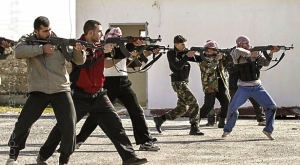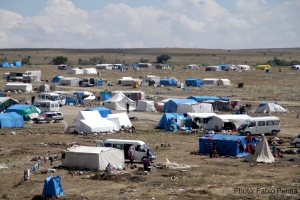Three years before Syria’s uprising in 2011, the country experienced the worst drought in recorded history. This unprecedented dry weather caused dramatic crop failure and livestock mortality in regions heavily dependent on agriculture. The drought was so severe that one and a half million Syrian farmers were forced to relocate to the outskirts of large cities– constituting a wave of internally displaced people who would later experience further hardships and civil unrest.

Syrian rebels aim their weapons during a training exercise outside Idlib
A recent study published in the Proceedings of the National Academy of Sciences (PNAS) shows that the Syrian drought was most likely exacerbated by human-caused climate change, and that these extreme weather events will be two to three times more likely in the future. The authors of this paper, Colin P. Kelly of UC Santa Barbara, Shahrzad Mohtadi of Columbia University, and their colleagues, insightfully connect the dots between human-driven climate change, the recent drought, and the Syrian uprising in March, 2011. They tease apart complex climate factors to show that climate change likely had a strong impact on the drought. Most importantly, this study serves as a reminder that climate change doesn’t need to kill directly to cause suffering. It only needs to be the tightening vice around our preexisting vulnerabilities: geopolitical instability, unsustainable agricultural policies, and disparities in wealth.

Syrian refugee tent city
Vulnerable. That is best way to describe Syrian agriculture as the drought descended in 2006. Unsustainable agricultural policies under Hafez al-Assad (1971-2000) led to the depletion of Syrian groundwater prior to the drought. If managed more sustainably this might have ameliorated the water shortages. On top of that, the country had not yet fully recovered from the drought of the 1990s.
As the drought continued to displace farmers, internal refugees came to constitute twenty percent of Syria’s total urban population. Prices of wheat, rice, and feed doubled and this only served to exacerbate resource constraints in urban areas. Bashar al-Assad ignored the growing issues of overcrowding, poor infrastructure, unemployment, and crime- all factors that contributed to the unrest that led to the civil war.

Syrian sheep in a parched landscape
In order to understand climate change’s role in the drought, and subsequently the uprising, the authors analyzed long term trends in precipitation and temperature. Essentially, Syria is getting hotter and drier in accordance with the pattern predicted by increasing greenhouse gas. Seven of the eleven years between 1998 and 2009 received less rainfall than the 1901-2008 normal. The authors also point out that “three of the four most severe multi-year droughts have occurred in the last 25 years”– the era of most intense human impact on climate. Climate change is believed to be increasing sea-surface pressure in the eastern Mediterranean which is suppressing westerly winds that typically bring rain to Syria. More alarming is that the authors cite a study which, “using a high-resolution model able to resolve the complex orography of the region concluded that the FC [Fertile Cresecent], as such, is likely to disappear by the end of the 21st century as a result of anthropogenic climate change.” It is deeply depressing that civilization will likely destroy its own birthplace.

Anasazi village
If connecting the dots between the Syrian crisis and climate change still seems like a leap of faith, just return to Jared Diamond’s book, Collapse, (which incidentally was published in 2005– the year before the Syrian drought started). Diamond’s account of the fall of the Anasazi Empire in the southwest of the United States around 1120 AD is an uncannily similar story. The Anasazi were a people accustomed to living in a dry landscape. Their agricultural practices worked for a period of time, but just like the Syrians, they employed techniques that lowered groundwater levels-leaving them vulnerable to drought. Before the Anasazi groundwater issue came to a head, their civilization prospered, and a ruling elite developed in city centers. Goods and food flowed in to the centers from the agrarian periphery. In 1117 AD the Anasazi experienced a severe drought that is believed to have led to severe strain on the agricultural system. Around the same time, walls and other fortifications were erected around the city centers– marking a period of civil unrest and warfare. It is believed that the farmers, forced to abandon their land, no longer tolerated the ruling elite, and the civilization fell into disarray. Archaeologists found scalped skulls and unburied bodies in the grand houses of the ruling elite from this time.
The similarities between the Anasazi and the Syrian crisis are clear. What’s different about the Syrian crisis today is that the weather events are no longer just forces of nature. Humans are exacerbating the climatic pressures that we have seen play a role in civil unrest and warfare. The 2011 drought in Russia caused a spike in food prices- a major cause of the Egyptian uprising. Recent reporting on Russia’s current drought notes that “it’s among the worst ever recorded”– words that feel surprisingly familiar when it comes to weather events these days. Let’s hope history doesn’t repeat itself… but surely it will.
____________________________________________________
Citation of the Original Scientific Article:
Kelley, C. P., Mohtadi, S., Cane, M. A., Seager, R., & Kushnir, Y. (2015). Climate change in the Fertile Crescent and implications of the recent Syrian drought. Proceedings of the National Academy of Sciences , 112 (11 ), 3241–3246. http://doi.org/10.1073/pnas.1421533112
Other Citations:
Russian drought “worst ever recorded” quote: http://bit.ly/1HJvZOd
Photo Credit:
Farmer feeling ground (featured image): Reuters, http://bit.ly/1ldekV7
Syrian Training: flikr, Freedom house
Refugees: flikr, EC/ECHO
Refugee tents: flikr, Fabio Pena
Sheep: Green Prophet, http://bit.ly/1lzZqb4
Anasazi: pixabay
Categories: Atmosphere, Uncategorized

Hey Adam,
Just finished reading you latest blog posting. Very well done. This one grabbed me- easy, as you say, to “connect dots” and understand what happened and why consequences are important and scary- and why we should care. I feel sad and alarmed.
Keep up the good work. see you both very soon.
Love Rick > On Dec 3, 2015, at 6:42 PM, EcoScienceWire >
LikeLike
Great article Adam and really interesting info you present. Climate change and the role with internally displaced persons is impossible to ignore looking at some root causes of the current crisis. Excited for more!!
LikeLike
This is really interesting. Thanks for the great article.
LikeLike